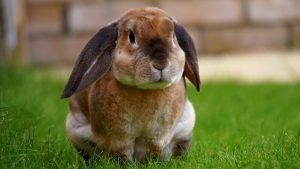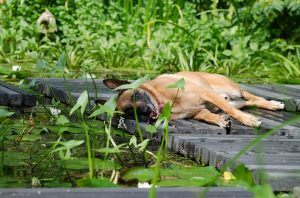We would all like to think that our garden is perfectly safe for the cats, dogs, rabbits, and fish that live with us. That it’s even beneficial to them. In most cases, that’s hardly far from the truth. But that doesn’t mean that aren’t risks in even the average garden that couldn’t risk t health of our fuzzy and not-so-fuzzy friends.

Link to Picture
Pests
Gardens invite pests. That’s not news to anyone who has them. If you’ve ever found a slug in your kitchen during the summer, then you know full well where it has come from. However, some of those pests can be a lot more dangerous than slugs. Mites and ticks are a growing problem here and your dog doesn’t have to pick them up from another. Besides checking your pets and treating them with preventative medicine, you should also look at making the garden less habitable for the pests in the first place. For instance, certain plants like chrysanthemums can keep them well away from your door.
Watch out for those weeds
Some animals will eat just about anything that catches their attention. Dogs especially seem to have a fondness for dandelions that, when eaten too much, can cause them serious stomach trouble. But there are other flowers and weeds that can be extraordinarily dangerous to them. Not just by being ingested, either. Foxtail is one weed you should entirely clear your garden of as it can release seeds that stick to and then burrow inside your pet’s’ flesh.

Keep the pond in the pond
If you mainly have terrestrial pets, then soggy ground is enough of a problem as it invites more weeds, moulds, and fungi that can then prove a danger to your animals. However, if you have fish, then you have a whole other reason to ensure that any ponds in your garden have at least one of the wide range of pond liners available. Without proper insulation, pond water will simply seep from the pond itself into the surrounding ground. Less water for the fish brings obvious danger to them and stagnates the water from the surrounding land. Meanwhile, it creates those unhygienic soil conditions that are bad for your pets as well.
Chemical poisoning
So far, we haven’t looked at any of the solutions that some of you might consider the most obvious ways to deal with the problems above. We haven’t looked at pesticides or herbicides yet and that’s for good reason. They are just as dangerous to your pets as they are to unwelcome intruders in the garden. Your garden is a safe place to revisit usually after 2-3 days of using chemical products which is easier to guarantee for cats and rabbits. For dogs, however, it can be difficult to justify keeping them inside for so long so you should look for natural alternatives instead. Companion plants instead of pesticides and mulch instead of herbicides, for instance.
Yet again, being a pet-owner means having to take out extra precautions to keep everybody safe. But if you’re like most of us, then that isn’t news nor is it something you would change for the world. There’s a chance your garden might be relatively safe, just make sure you stay on top of it.
*This is a helpful collaborative post*